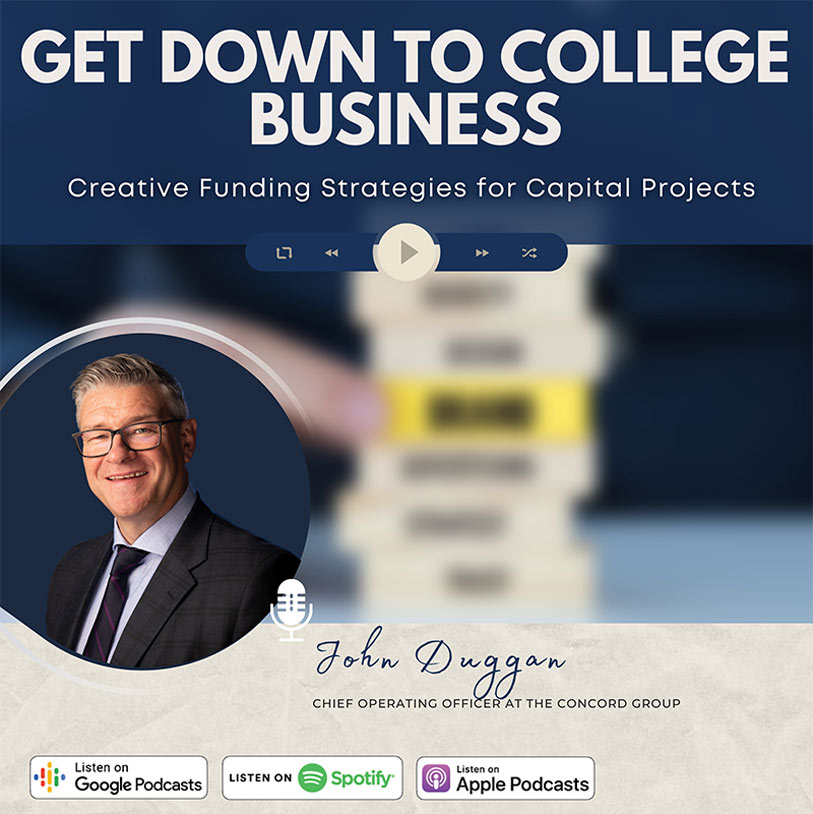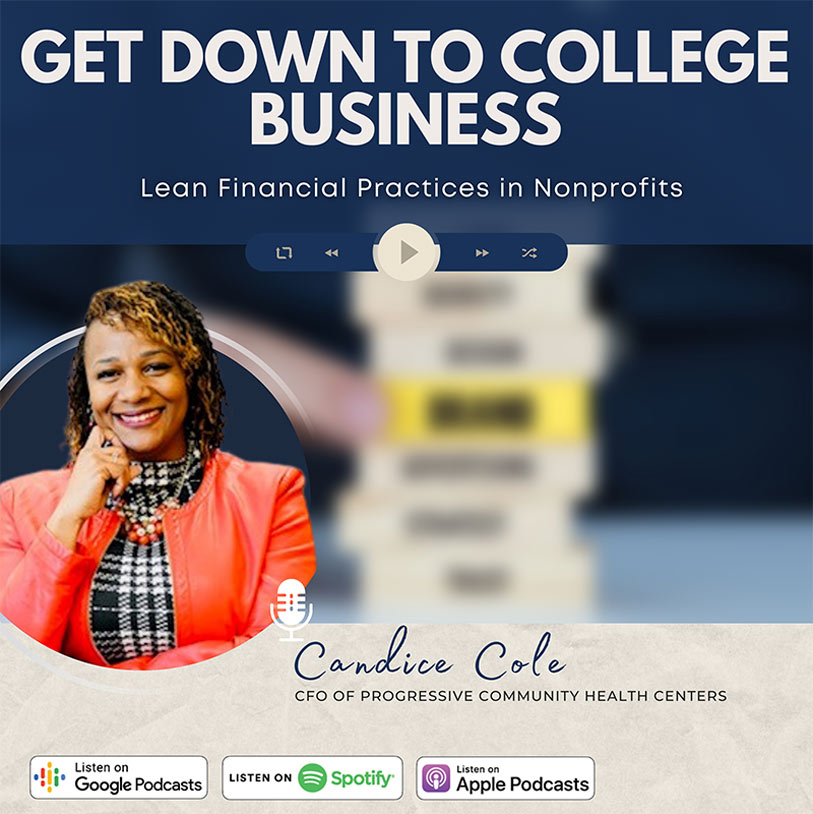COMING AUGUST 29
Dr. Sarah Holtan talks to Kevin Gilligan
The Economics of Nursing Education
COMING AUGUST 15
Dr. Sarah Holtan talks to Teri Kaul, PhD, APRN-BC
Creative Funding Strategies for Capital Projects
COMING August 1
Dr. Sarah Holtan talks to John Duggan
Lean Financial Practices in Nonprofits
Dr. Sarah Holtan talks to Candice Cole
Continue readingThe Cost of Brick and Mortar
Dr. Sarah Holtan talks to Scott Lindvall
Continue readingThe Educational and Monetary Value of DEI
Dr. Sarah Holtan talks to Charnetta Gadling-Cole, PhD
Continue readingThe Cost of Cultural Change
Dr. Sarah Holtan talks to Darrell Bazzell
Continue readingFixing the Broken Rung on the Higher Ed Leadership Ladder
When women trip on that first rung of the leadership ladder, they never catch up. Women in entry-level positions are promoted to managerial positions at much lower rates than men in corporations. Only 87 women overall are promoted for every 100 men from entry-level to management positions (McKinsey and LeanIn.org). This is referred to as the broken rung of early career leadership progression. The broken rung isn’t limited to corporations – it’s prevalent in higher education institutions, too.
Gender inequality needs to be tackled at the organizational level, and not targeted to male leaders and coworkers. Below is some of the research, combined with first-hand experiences, to guide the discussion.
Is a Leaky Pipeline the Problem?
There are more female professionals than males in nearly all functional units of higher education. Females hold 60% of professional roles in higher education, yet they represent far fewer leadership positions and are still underpaid compared to males, according to a 2022 CUPAHR report. Females of color fare even worse in leadership representation and pay.
Women are also more educated than men. The majority of students seeking and attaining bachelor’s and master’s degrees are female. Nearly 60% of students are female and 40% are male (National Student Clearinghouse).
A lack of ambition for females is not a cause, either. Nearly 50% of women overall describe themselves as “very ambitious” in regards to their careers, according to a 2022 CNBC survey. Ambition rates are highest for Black women, with 66% describing themselves as “very ambitious.”
The data shows the problem is not due to a leaky pipeline. There are plenty of females with educational credentials, professional experience, and ambition. So if it’s not a pipeline issue, what is causing the broken rung at institutions of higher education?
What are Some Causes of the Broken Rung?
There are a handful of causes that contribute to the broken rung.
- Change Resistance. The decision-makers may not see a need for change. Change might not benefit them whereas status quo does (World Economic Forum). Or maybe change is not a priority for the decision-makers. Other priorities will rise to the top. Addressing leadership equality may be perceived as lower priority rather than essential for sustainable organizational success.
- Lack of Representation. As the data demonstrates, there are fewer females in leadership positions and therefore, hiring positions. The lack of diversity in hiring managers may perpetuate the problem. With less representation, there is less role modeling, too. The first female in any leadership role has a bumpier path to traverse and will be under more scrutiny.
- Gendered Cultural Norms. Some colleges have a culture of opportunity for males. Males may be solicited more often for stretch projects, highly-visible projects, and informal networking opportunities (e.g., golfing). By contrast, females may be expected to take on more of the non-promotable work (The No Club). Non-promotable work is essential for organizations but doesn’t lead to advancement. Examples are taking minutes of meetings, planning the parties, undertaking DEI and well-being work, and serving on more committees. When females do the non-promotable work, they stretch themselves thin, which leads to burnout. It also creates more space for men to do the promotable work. In my own experience, I saw this happen time and again. Like some of my female coworkers, I tended to fall in line with gendered cultural expectations of the workload. For years, I did not feel empowered enough to challenge the non-promotable tasks. I just did them, usually with a smile.
Organizations may tolerate gender-based microaggressions, which can be manifestations of unconscious bias. The microaggressions include females having their judgment questioned even when they are the technical expert in the room, being mistaken for someone with less experience, not being given credit for their work, and receiving comments on their appearance, personality, and perception of friendliness. - Policies and Practices. There are structural elements, such as employee policies and corresponding practices, that also contribute to the broken rung. Any policy or practice that favors one gender over another, even subtlety, can adversely affect the promotional opportunities for the outsider group. An example is the time allotted for a professor to be granted tenure. A female may need extra time to satisfy the requirement for tenure. The standard timeline may disadvantage females, considering the 2.5 times extra domestic laborburden they experience.
As for practices, females need mentors, coaches, sponsors, and allies from the majority group. The organization should intentionally create the structures for these relationships. - Lack of External Pressures. Non-profit colleges and universities do not have the same external drivers as for-profit corporations. The shareholders of corporations are demanding diversity and equity in the leadership pipeline now. (Albeit, with a long way to go to achieve equal representation and pay!) The consumer demands of corporations also influences the hiring and promotion practices. However, there are fewer pressures to address the gaps and make the changes in higher ed.
What are Some Promising Solutions?
A first step toward fixing the broken rung is to know exactly what’s happening at a specific college or university. Human Resources can mine employment data to discover trends in hiring practices. For example, HR can identify which functional units have specific gender gaps in managerial promotions (e.g., academics, student affairs, support services) and where the pay inequity resides. HR can also conduct anonymous feedback surveys to gauge the experiences of employees. It’s important to identify where the employees experience and perceive obstacles to advancement.
Examine structural barriers inherent in the policies and practices and remove them. Modern care-giver policies can partially equalize the working conditions. Both parents need adequate paid time-off when a new child is born, adopted, or fostered. Other care-givers need time to care for aging parents and medical conditions of family members. Remote work, flexible hours, and shared jobs can also address care-giver needs. As a solo parent myself, I would argue that single-parent households would benefit from additional considerations, such as limited travel expectations.
The sexual harassment policies must be strict with safe reporting processes in place. The enforcement of the sexual harassment policies must be consistent. All employees should be trained on the policies and expected to comply at equal levels.
All employees need equal access to formal and informal mentorship, sponsorship, coaching, and ally-ship. A serious approach would be to tie the access to the job expectations of senior leaders.
It is important to note that policies and practices must achieve two levels of equality: discouraging inequality andencouraging equality. For example, it is not enough to state that employees in protected demographic groups (e.g., sex, gender) will not be discriminated against. The policies must also encourage equality by stating how all employees will be assured equal rights, responsibilities, and privileges and describe how that will happen. The corresponding practices should consistently uphold the rights, responsibilities, and privileges as stated in the policies.
Call out hidden and subtle barriers, such as unequal non-promotable workloads and microaggressions. Subtle barriers can create a toxic workplace culture. Employees are leaving these organizations at higher rates than organizations with healthy cultures (MIT 2022).
Our expectations for workplace culture and gender parity are evolving. The research is, too. I welcome additional insights on the causes of the broken rung in higher ed and how to fix them.
In the Trenches of Operational Efficiency
Dr. Sarah Holtan talks to Scott Converse
Continue readingAmplifying the Business of Higher Ed
Dr. Sarah Holtan talks to Suzy Siegle, EdD
Continue reading









